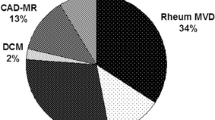Summary
Problem: Atrial fibrillation is associated with significant morbidity and mortality. The increased risk of thromboembolism makes constant anticoagulation necessary, while the absence of atrial contraction worsens the hemodynamic situation. In this study we examined the results of simultaneous surgical treatment of chronic atrial fibrillation through “Cox/Maze-III-procedure” while mitral valve surgery and atrial septal closure. Patients and methods: Between February 1995 and July 1997 sixteen patients aged 50 to 72 y (mean: 59 y) underwent open heart surgery (mitral valve replacement n = 10, reconstruction n = 3; mitral valve reconstruction and atrial septal closure n = 1, atrial septal closure n = 1, thrombectomy from left atrium n = 1) and “Cox/Maze-III-procedure” in one session. Preoperative duration of chronic atrial fibrillation was between 2 and 12 y (nean: 5.0 y). The patients were examined preoperatively and postoperatively 3, 6, 12, and 24 month after surgery using the following methods: transesophageal echocardiography (TEE), ECG, long-term ECG, and stress ergometry. Results: During the early postoperative period (< 7 d) all of the patients were in sinus rhythm or atrial pacing; eight patients intermittently had atrial fibrillation. In the follow-up period from 1 to 27 months (mean 14 months), 15 patients have a stable sinus rhythm (94%). One patient, preoperatively known to have intermittent tachybradycardia, received a pacemaker 2 months postoperatively for sinus bradycardia. Postoperatively in TEE patients showed left atrial contraction with improvement of hemodynamic situation. Stress ergometry 6 months postoperatively showed lower increasements of heart rate, at 12 months normal frequency. Conclusion: The surgical treatment of chronic atrial fibrillation through “Cox/Maze-III-procedure” can be performed combined with other heart operations without increased perioperative or postoperative risks. The Maze-procedure is an effective surgical therapy of chronic atrial fibrillation. Postoperatively there is an improvement of the hemodynamic situation of sinus rhythm and synchrone atrioventricular contraction.
Zusammenfassung
Problem: Vorhofflimmern geht mit einer signifikanten Morbidität und Mortalität einher. Das erhöhte Thrombembolierisiko erfordert eine dauerhafte Antikoagulation, die fehlende Vorhofkontraktion verschlechtert die hämodynamische Situation. Die vorliegende Studie untersucht die Ergebnisse einer chirurgischen Therapie des chronischen Vorhofflimmerns mittels der“Cox/Maze-III-Operation”, die während Mitralklappen-, ASD-II-Operationen und einer Thrombektomie aus dem linken Vorhof (LA) durchgeführt wurde. Patienten und Methoden: Von 2/95 bis 5/97 wurde bei 16 Patienten im Alter zwischen 50 und 72 Jahren (Mittel 59 Jahre) während einer Herzoperation die chirurgische Therapie des chronischen Vorhofflimmerns mittels “Cox/Maze-III-Operation” durchgeführt. 13 Patienten erhielten eine Mitralklappenoperation (Ersatz n = 10, Rekonstruktion n = 3). Bei weiteren drei Patienten wurde eine Mitralklappenrekonstruktion mit ASD-II-Verschluß, ein ASD-II-Verschluß oder eine Thrombektomie aus dem LA durchgeführt. Die präoperative Dauer des chronischen Vorhofflimmerns lag zwischen 2 und 12 Jahren (Mittel 5,0 Jahre). Die Patienten wurden präoperativ sowie 3, 6, 12 und 24 Monate nach der Operation mittels transösophagealer Echokardiographie (TEE), EKG, Langzeit-EKG und Belastungsergometrie nachuntersucht. Ergebnisse: In der frühen postoperativen Phase (<7 die) befanden sich alle Patienten im Sinusrhythmus oder Vorhofpacing. Intermittierend bestand bei 8 Patienten Vorhofflimmern. Während des Nachbeobachtungszeitraums von 1 bis 27 Monaten (Mittel 14 Monate) hatten 15 Patienten einen stabilen Sinusrhythmus (94%). Ein Patient erhielt 2 Monate postoperativ, wegen Sinusbradykardie, einen Schrittmacher (6%). Postoperativ zeigten die Patienten im TEE bei synchronen atrioventrikulären Kontraktionen eine Verbesserung der präoperativen Hämodynamik. In der Ergometrie fanden sich 6 Monate postoperativ niedrigere Frequenzanstiege, 12 Monate postoperativ jedoch Sinusrhythmus mit adäquaten, belastungsabhängigen Frequenzanstiegen. Schlußfolgerung: Die chirurgische Therapie des chronischen Vorhofflimmerns mittels der "Cox/Maze-III-Operation" ist in der Kombination mit anderen Herzoperationen ohne erhöhtes peri- bzw. postoperatives Risiko durchführbar und kann als effektive chirurgische Therapie des chronischen, medikamentös therapiefraktären Vorhofflimmerns angesehen werden. Postoperativ kommt es zu einer deutlichen Verbesserung der Hämodynamik durch Entstehen von Sinusrhythmus mit synchronen atrioventrikulären Kontraktionen.
Similar content being viewed by others

Author information
Authors and Affiliations
Additional information
Eingegangen: 15. September 1997 / Akzeptiert: 10. Dezember 1997
Rights and permissions
About this article
Cite this article
Musci, M., Pasic, M., Siniawski, H. et al. “Cox/Maze-III-Operation” als chirurgische Therapie des chronischen Vorhofflimmerns während Mitralklappen- und ASD-II-Operation. Z Kardiol 87, 202–208 (1998). https://doi.org/10.1007/s003920050172
Issue Date:
DOI: https://doi.org/10.1007/s003920050172



